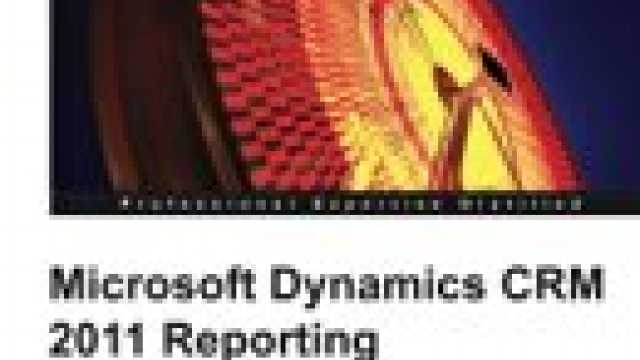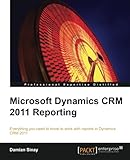Microsoft Dynamics CRM 2011 Reporting and Business Intelligence
Microsoft Dynamics CRM 2011 Reporting and Business Intelligence
Everything you need to know to work with reports in Dynamics CRM 2011 Overview Create reports with SQL Reporting Services for CRM Empower your reports with the different Report Wizards and dashboards Troubleshoot and optimize your reports for better performance In Detail All of the data entered into a CRM means nothing if it is unable to report the important information to our managers and executives in such a way that they can easily and quickly get the results they need. A better reporting system would enable them to make the necessary improvements to the processes that any business needs in a dynamic business world.For users and developers wishing to take advantage of using the report capabilities of Dynamics CRM, this is the book for
List Price: $ 49.99
Price: $ 45.90
Few More:
 Microsoft Dynamics CRM 2011 Step by Step
Microsoft Dynamics CRM 2011 Step by StepThe smart way to learn Microsoft Dynamics CRM 2011—one step at a time! Use the easy-to-follow lessons to master the fundamentals…
 Microsoft MB2-704 Exam: Microsoft Dynamics CRM Application
Microsoft MB2-704 Exam: Microsoft Dynamics CRM ApplicationMB2-704 practice exam will help you prepare for your exam in shortest possible time. This MB2-704 practice exam guarantee you will…



Want to become a Microsoft CRM 2011 reporting ninja?,
Well, you can thank Damian Sinay because he has written an excellent book that pulls together just about every way there is to write and deploy reports in CRM 2011. From the Report Wizard, to writing RDL in Visual Studio using FetchXML, to ASP.NET web pages that expose CRM reports in real time on regular web sites–if you’re serious about developing and deploying Microsoft CRM 2011 reports, you need this book.
Microsoft Dynamics CRM 2011 Reporting starts us off with the Report Wizard. Then we go into SQL Reporting Services, which is the back end reporting system for MSCRM on-premise and online.
From there it’s download-RDL-from-CRM-into-Visual-Studio and all of a sudden you have genuine, professional reports that have exactly the data you want and look exactly the way you want.
One caveat: All the SQL Server stuff (mostly programming against the SRS instance that backs CRM) is not available if you use CRM Online because in CRM Online Microsoft doesn’t expose the direct access to SRS or the SQL database that you need to make that work.
Don’t worry, though because Damian brings it with the most thorough development of FetchXML (works on-premise, online and from inside the CRM client) I’ve ever seen in one place. Here’s just one example: a step-by-step on how to get FetchXML Intellisense going in Visual Studio. Seriously? CRM and Intellisense? Yes!
Speaking of, the wizard doesn’t give you much control of the layout–for that you need Visual Studio, and Damian steps us through exactly how to get a wizard-generated RDL file into Visual Studio where we can bend that report precisely to our will.
Since this method works for CRM on-premise and CRM Online, if you’re serious about learning portable MSCRM reporting skills–learn FetchXML and use the RDL editor in Visual Studio to make the reports do exactly what you want.
Want to embed your shiny cool report inside a CRM form? Chapter 6 shows you how, in a very nicely written step-by-step. You also get to see the new package editor from the SDK–a must have if you’re going to make your reports into a CRM solution (which you should always do.)
In Chapter 7 Damian lets out a big CRM secret–dashboard panes are just reports. Yup. Once you’ve built the thing, plug it into a dashboard window and everyone will know your power.
Not challenging enough for you? Then head over to chapter 8 and write some ASP.NET pages that use FetchXML to populate standard ASP.NET report and chart controls. This is a great option to create server-side report distribution to people who don’t have the CRM client.
And you’ll be glad to know that CRM 2011 (as long as you have UR12/Polaris with the updated forms) will deliver your awesome reports to iThings, Surfaces, almost all kinds of mobile device and tablets, and the best part is that you don’t have to do much beyond just taking the credit.
To really rock your MSCRM reporting world, you’ll want at least passing familiarity with CRM advanced find, SRS, BIDS, and Visual Studio, because that’s what you use when you’re a CRM reporting ninja.
Like Damian Sinay.
Was this review helpful to you?

|This book is clear and concise and offers much more information than I expected,
The book starts out with an introduction to reporting that covers all the basics from report types all the way to Installation and configuration of the “Report Authoring Extension” for Visual Studio. The second chapter has a great overview of SQL terminology from select to group by.
The third chapter jumps right into creating your first report and publishing using report wizard or Visual studio.
There is information on using SQL Server Report builder from SSRS which the author feels is better than wizard and great if you don’t have visual studio.
There are clear instructions on how to create reports in report wizard, exporting the RDL to modify them and then load them back up to run them.
The books covers more advanced topics such as Contextual Reports, Inline Reports, web resources, the developer toolkit, Dashboards, advanced custom reporting and automation. The book ends with a chapter on failure recovery, authentication and performance and then a final chapter on using the mobile client and the sales process.
I have looked for training guides in the past – but I always had trouble finding books specific to the product but also giving the basics behind reporting services. This book is clear and concise and offers much more information than I expected.
I am looking forward to using Microsoft Dynamics CRM 2011 Reporting book for training my staff on reports in Microsoft Dynamics CRM.
MariAnne Woehrle, Senior Director of IT, CTAM, National Harbor, MD
Was this review helpful to you?

|